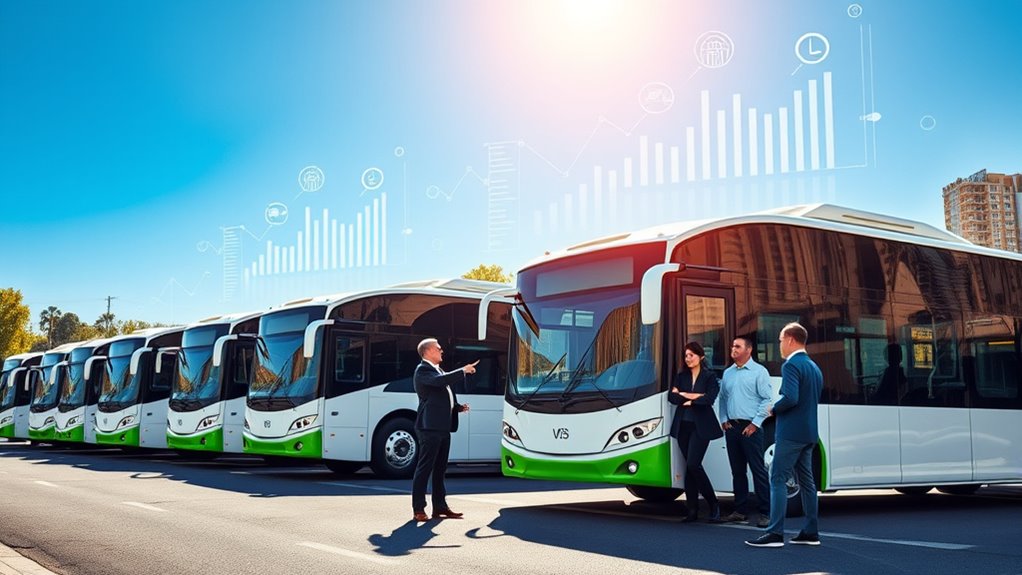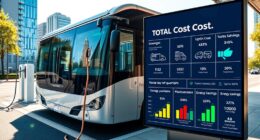To finance your electric bus fleet, you can explore options like government grants, utility incentives, and specialized leasing programs that help reduce upfront costs. Many utility companies offer rebates and support for charging infrastructure, while manufacturers provide tailored financing solutions or leasing arrangements to spread out expenses. Municipal programs and tax-exempt leases are also available for public fleets. Keep exploring, and you’ll find more ways to make your conversion to electric buses more affordable and efficient.
Key Takeaways
- Specialized financing solutions from banks and leasing companies help manage high upfront costs of electric bus fleets.
- Grants and utility incentives reduce initial investment expenses for purchasing and installing charging infrastructure.
- Lease agreements and rental options offer flexible, cost-effective ways to acquire electric buses without large capital outlays.
- Municipal and government programs provide tax-exempt financing and tailored funding options to support fleet electrification.
- Partnerships with manufacturers and financial providers streamline financing, leasing, and fleet management for electric bus deployment.

Are you exploring ways to finance an electric bus fleet? Moving to electric vehicles involves upfront costs that can seem intimidating, but various funding options are available to ease the financial burden.
Government and institutional funding are significant sources, with federal, state, and local agencies offering grants and subsidies to support fleet electrification. These grants help offset the higher initial investment in electric buses compared to traditional diesel models. Often, partnerships with schools and municipalities facilitate access to such funding, especially when combined with utility provider incentives that promote clean transportation.
Government grants and utility incentives help offset electric bus costs and support fleet electrification efforts.
Utility companies can also offer grants, rebates, or make-ready programs that cover electrical upgrades and charging infrastructure, making the switch more affordable and streamlined. Additionally, many utility programs are designed to support charging station deployment, further reducing barriers to adoption.
In addition to grants, partnering with financing providers can make a substantial difference. Companies like International Financial and Daimler Truck Financial specialize in tailored financing options for electric fleets, including solutions with no mileage limitations or bridge financing to cover initial expenses.
These providers aim to reduce the barriers of high upfront costs, helping you manage cash flow more effectively. Many financing partnerships work directly with bus manufacturers, such as Thomas Built Buses, to offer aligned solutions that simplify the entire process and provide immediate operational savings.
This approach not only eases your financial planning but also accelerates your fleet’s electrification timeline. Consulting with financing experts can help you identify the most suitable options based on your specific fleet needs and budget constraints.
Leasing and rental options offer another flexible pathway. Leasing electric buses allows you to avoid large capital expenditures by spreading costs over time.
Different types of leases are designed to suit your operational needs, whether for short-term trials or long-term fleet management. Leasing agreements often include fleet management services, helping optimize vehicle usage and maintenance.
As the market matures, used electric buses may also become available for lease, offering further cost-effective options. Additionally, electric vehicle incentives provided by government programs can significantly reduce the overall acquisition cost for your fleet.
Renting can be especially advantageous if you want to test electric buses before making a full commitment, or if your fleet requirements fluctuate seasonally or due to contract work.
Utility providers play an essential role in financing the infrastructure needed for electric fleets. Many offer programs that cover electrical upgrades or provide grants for charging stations, helping distribute costs among stakeholders.
Some utility companies even purchase buses outright or finance both buses and charging systems through specialized programs. These collaborations make it easier to plan your switch, ensuring you have the necessary charging capacity without overextending your budget.
Additionally, municipal financing options, such as tax-exempt lease purchases, are designed specifically for public fleets facing budget constraints, offering customizable solutions that combine both vehicle and infrastructure financing under one plan.
Frequently Asked Questions
What Are the Tax Incentives Available for Electric Bus Fleet Investments?
You can take advantage of federal tax incentives like the Qualified Commercial Clean Vehicle Credit, offering up to $40,000 per electric bus over 14,000 pounds, and use the IRS safe harbor to simplify calculations.
State and local incentives, such as sales tax exemptions, rebates, and reduced registration fees, further lower costs.
Infrastructure credits, grants, and other programs also support your investment, making electric buses more affordable and financially attractive.
How Do Leasing Options Compare to Purchasing for Electric Bus Fleets?
Thinking about your electric bus fleet is like choosing between planting a sapling or buying mature trees. Leasing offers lower upfront costs, flexible upgrades, and included maintenance, making it easier to adapt.
Purchasing gives you full control, no mileage limits, and potential resale value for long-term gains.
Weigh these options based on your business needs—leasing for flexibility or purchasing for ownership and customization.
Are There Grants Specific to Electric Bus Infrastructure Development?
You’re asking if there are grants specifically for electric bus infrastructure development. Yes, several government programs support this, like the FTA’s Bus and Bus Facilities Program, which funds both buses and charging stations.
The Clean School Bus Program also offers grants for charging infrastructure. These grants aim to reduce emissions, promote sustainability, and modernize transit systems, making it easier for you to develop and expand electric bus infrastructure effectively.
What Is the Typical ROI Timeframe for Electric Bus Fleet Investments?
The typical ROI timeframe for electric bus fleet investments is around 3.6 years, meaning you can expect to recover your initial costs through savings within this period.
Electric buses offer lower operating and maintenance costs, which help accelerate ROI.
Factors like technological improvements, operational efficiency, and government incentives can further reduce this timeframe, making the switch to electric buses a smart financial move for your fleet.
How Can Private Investments Support Electric Bus Fleet Financing?
Like a guiding light in a foggy night, private investments can illuminate your path to funding electric bus fleets. They provide flexible financial resources, reduce upfront costs, and help mitigate risks, making the shift smoother.
Conclusion
By exploring these financing options, you can smoothly steer your electric bus fleet toward a sustainable future. While the road may have gentle turns and subtle shifts, each opportunity offers a chance to embrace cleaner transportation. With careful planning and strategic choices, you’ll find yourself on a promising path, where innovation and efficiency quietly harmonize. Ultimately, the right financial approach can help you navigate this progression with confidence, guiding your fleet toward a brighter, greener horizon.









